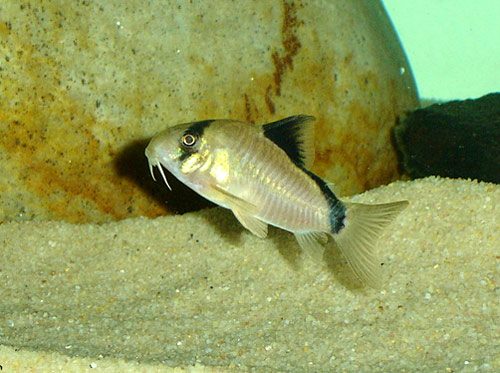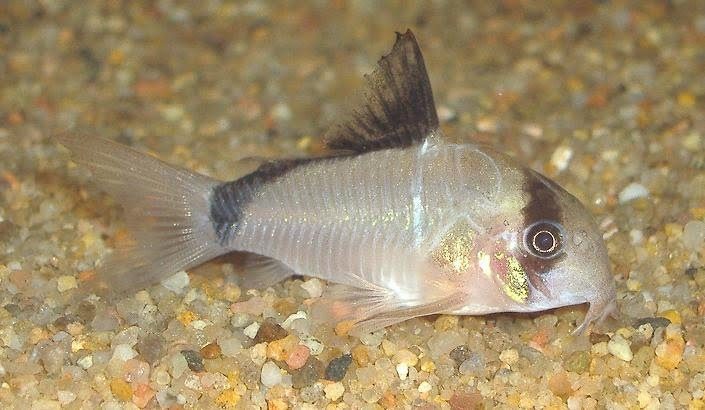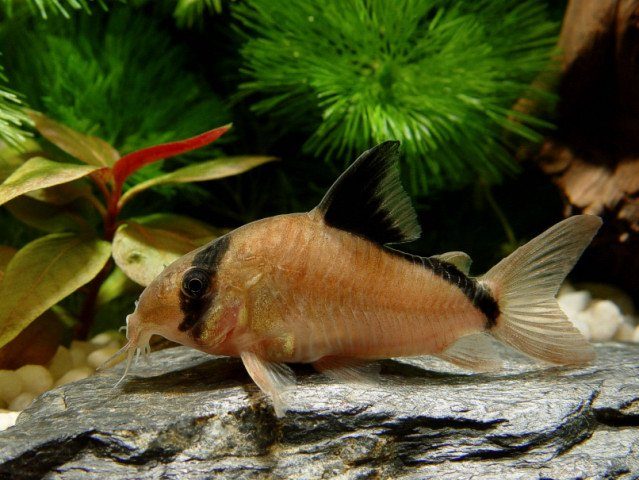




Bandit corydoras was originally described by Carl H. Eigenmann in 1914. It is an armoured catfish which possess two rows of bony plates instead of scales running along the flanks. The genus name is composed of the Greek words cory, meaning helmet and doras, meaning skin. The body has black bands which consist of a vertical stripe through the eye that gives the popular name ‘Bandit catfish’. The species ‘metae’ was named after Rio Meta, the river where it was first found.
The bandit corydoras requires at least 20 gallons aquarium but larger is recommended. They are extremely peaceful and schooling fish which should be kept in groups of at least 3-6 fish or more. Temperature of the tank water should be maintained 72-79 0F because corydoras gets easily stressed by cooler temperatures. They are also sensitive to poorly maintained or dirty substrates and can lose their barbells if they are kept in poor conditions. The water should be soft, pH in the range of 6.5 to 7.0 and hardness in the range of 5-10 dGH.
Corydoras can be kept in most community and planted aquariums with fish like tetras, danios, rasboras, livebearers, Guppies, Mollies, Platies, Swordtails, Tetras, Barbs Discus, Angelfish, Gouramis, Rainbow fish and Plecos. Tank should be decorated with broad-leaf plants and crevices under rocks or other ornaments for hiding places as well as some open areas for swimming room. A few dried leaves are essential to mimic their natural habitat. Substrate with sharp or jagged edges should be avoided because that can irritate and damage their undersides and barbells. In this case fine or sandy substrates are best. The water should be filtered through peat and 50 % of the tank water needs to replace at least once a month. The lighting should not be too bright.
It is omnivorous fish and in wild condition, it feeds wide variety of foods such as worms, benthic crustaceans, insects, and plant matter. They also eat any dead, dying or even injured fish. In captive condition it should be supplemented with live and frozen foods such as Daphnia, Artemia and bloodworm. It is a bottom dweller and it eats most food which sinks to the bottom of the tank. Sinking algae pellets with flake food or other sinking foods like catfish pellets should be offered to ensure proper nutrition.
It is omnivorous fish and in wild condition, it feeds wide variety of foods such as worms, benthic crustaceans, insects, and plant matter. They also eat any dead, dying or even injured fish. In captive condition it should be supplemented with live and frozen foods such as Daphnia, Artemia and bloodworm. It is a bottom dweller and it eats most food which sinks to the bottom of the tank. Sinking algae pellets with flake food or other sinking foods like catfish pellets should be offered to ensure proper nutrition.
Bandit Corydoras is easy to sex when it is viewed from above. The female is much rounder and wider than the male. The male is smaller overall than the female in size. The ventral fins of the mature male are more pointed than those of the female.
The Bandit Corydoras aren’t an easy fish to find for sale. They are typically sold from breeders or imported into the country. Looking for where to buy some Bandit Corydoras? Check out below for some recommendation of online vendors selling these fish.